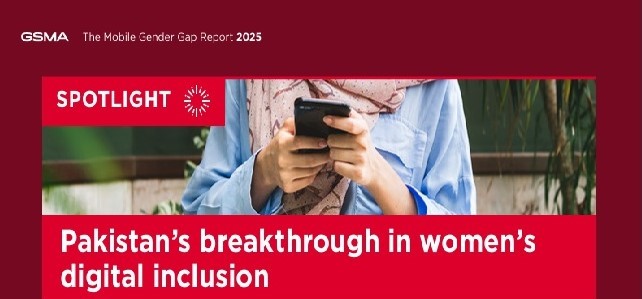GSMA Report has lauded the telecos and the telecom sector regulator for the improvements.
The Mobile Gender Gap Report 2025, released by the GSMA, Wednesday has said that in South Asia, the gender gap in mobile internet adoption in 2024 remained relatively unchanged at 32 percent with 330 million women in the region still not using it.
The GSMA report has highlighted that the mobile internet adoption was the highest at 45 percent among women in Pakistan compared to Bangladesh and India. The mobile internet adoption in 39 percent and 26 percent in India and Bangladesh respectively.
This change was the result of a significant increase in the proportion of women in Pakistan using mobile internet from 33 percent in 2023 to 45 percent in 2024.
The GSMA report has added that the large increase in mobile internet adoption by women in Pakistan in 2024 was primarily drive by rural women.
Amid continuous rise in several years mobile internet adoption among women, witnessed a massive jump in 2024 as the ‘mobile internet gender gap’ narrowed, from 38 percent to 25 percent, meaning that women in Pakistan were 25 percent less likely than men to be using mobile internet.
However, adoption by men also increased by seven percentage points in 2024.
The GSMA has also said that Pakistan also tops in South Asia for ‘Mobile Ownership’ among men with 93 percent, while 71 percent men in India and 68 percent in Bangladesh have mobile ownership.
The GSMA has lauded the telecos and the telecom sector regulator for the improvements.
“Pakistan Telecommunication Authority launched a Digital Gender Inclusion Strategy20 aiming to address the digital divide by creating more inclusive opportunities for women,” the report said and referred to lauded Jazz, Telenor and Ufone for striving to increase the proportion of women in their mobile internet customer base as part of the GSMA Connected Women Commitment Initiative.
Welcoming the statistics the industry players have highlighted that around eight million women came online in 2024 and Jazz CEO Aamir Ibrahim said that opportunities were increasingly digital in the current world and smartphone in a woman’s hand is the biggest equaliser.
“However the challenges exists in rural and low-income areas, where entrenched social norms and affordability remain major barriers,” Mr Ibrahim said adding that in many communities, smartphone ownership was still seen as a threat for women.
“This mind-set will not change unless we engage not just women, but also fathers, brothers, and decision-makers in the household,” he said.
The telecos have Pakistan have been calling for tailor-made solutions, such as instalment-based smartphone purchase plans and localised digital literacy programmes to tackle the issues together.
Meanwhile the GSMA report has added, “Awareness of mobile internet was extremely high among both men and women in Pakistan, with little gender difference of 89 percent and 86 percent respectively.”
The GSMA has suggested that awareness was essential for more women to adopt mobile internet and use it safely and autonomously.
However the GSMA has said that despite strong growth in mobile internet adoption from 2023 to 2024, smartphone ownership did not increase to the same degree in Pakistan, mainly due to the high prevalence of phone borrowing among women to use the internet.
It added that 35 percent of female mobile internet users in Pakistan do not own an internet-enabled phone and are borrowing one to get online, but borrowing someone else’s mobile phone to get online was an important step in women’s mobile internet user journey in Pakistan. It should be noted that women who do not own an internet-enabled device are much less likely to use mobile internet on a daily basis than those who do own one, the GSMA has said.







